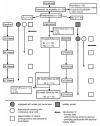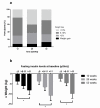Weight Reduction by the Low-Insulin-Method-A Randomized Controlled Trial
- PMID: 33007918
- PMCID: PMC7601801
- DOI: 10.3390/nu12103004
Weight Reduction by the Low-Insulin-Method-A Randomized Controlled Trial
Abstract
Continuous high insulin levels are associated with weight gain and lead to cardiometabolic diseases. Therefore, we have developed the Low-Insulin-Method and integrated it into the multi-component, occupational healthcare program SHAPE-AND-MOTION-Medical-Accompanied-Slimming (SAMMAS) to reduce daily insulin levels for long-term weight reduction in overweight or obesity. Employees were randomized into a starting intervention group (SI, n = 15) or waiting list control group (WL, n = 15). SAMMAS consisted of group-based seminars, low-carbohydrate nutrition including formula diet, continuous glucose monitoring, telemetric monitoring, and telemedical coaching. Both groups received telemetric devices at baseline. Intention-to-treat analyses were performed after 12, 26, and 52 weeks. The estimated treatment difference in weight reduction after 12 weeks, which is the primary endpoint of the study, showed a pronounced effect in favour of SI (-6.3 kg with (95% confidence interval) (-7.4; -4.5) (p < 0.001)) after 12 weeks. Furthermore, SI improved fasting blood glucose, HbA1c, quality of life, fasting insulin, blood pressure, and eating behaviour (all p < 0.05) in the within-group analysis, while WL did not. After 26 and 52 weeks, weight reduction could be maintained in the whole group (both groups together) by -6.7 kg (-9.5; -3.8) (p < 0.001) and -6.1 kg (-9.2; -2.7) (p < 0.01). SAMMAS supports clinically relevant weight reduction and long-term weight loss maintenance in individuals with overweight or obesity.
Keywords: RCT; meal replacement therapy; telemedical coaching; weight loss.
Conflict of interest statement
K.K., S.M., S.E., M.R., M.S., and K.M. declare that there are no competing interests regarding this publication.
Figures



Similar articles
-
Telemedical coaching for weight loss in overweight employees: a three-armed randomised controlled trial.BMJ Open. 2019 Apr 11;9(4):e022242. doi: 10.1136/bmjopen-2018-022242. BMJ Open. 2019. PMID: 30975666 Free PMC article. Clinical Trial.
-
Individualized Meal Replacement Therapy Improves Clinically Relevant Long-Term Glycemic Control in Poorly Controlled Type 2 Diabetes Patients.Nutrients. 2018 Aug 4;10(8):1022. doi: 10.3390/nu10081022. Nutrients. 2018. PMID: 30081574 Free PMC article. Clinical Trial.
-
Personalized Web-Based Weight Loss Behavior Change Program With and Without Dietitian Online Coaching for Adults With Overweight and Obesity: Randomized Controlled Trial.J Med Internet Res. 2020 Nov 5;22(11):e17494. doi: 10.2196/17494. J Med Internet Res. 2020. PMID: 33151151 Free PMC article. Clinical Trial.
-
Online platform for healthy weight loss in adults with overweight and obesity - the "POEmaS" project: a randomized controlled trial.BMC Public Health. 2018 Aug 1;18(1):945. doi: 10.1186/s12889-018-5882-y. BMC Public Health. 2018. PMID: 30068393 Free PMC article.
-
Impact of Physical Activity and Weight Loss on Fat Mass, Glucose Metabolism, and Inflammation in Older African Americans with Osteoarthritis.Nutrients. 2020 Oct 28;12(11):3299. doi: 10.3390/nu12113299. Nutrients. 2020. PMID: 33126555 Free PMC article. Clinical Trial.
Cited by
-
Comparative Effectiveness of Cognitive Behavioral Therapy and Behavioral Therapy in Obesity: A Systematic Review and Network Meta-Analysis.J Clin Psychol Med Settings. 2025 Mar;32(1):96-110. doi: 10.1007/s10880-023-10000-6. Epub 2024 Jan 29. J Clin Psychol Med Settings. 2025. PMID: 38285378
-
The impact of behavioral weight management interventions on eating behavior traits in adults with overweight or obesity: A systematic review and meta-analysis.Obes Rev. 2025 Apr;26(4):e13871. doi: 10.1111/obr.13871. Epub 2024 Nov 21. Obes Rev. 2025. PMID: 39572922 Free PMC article.
-
Effects of a Protein-Rich, Low-Glycaemic Meal Replacement on Changes in Dietary Intake and Body Weight Following a Weight-Management Intervention-The ACOORH Trial.Nutrients. 2021 Jan 26;13(2):376. doi: 10.3390/nu13020376. Nutrients. 2021. PMID: 33530530 Free PMC article. Clinical Trial.
-
Continuous and Flash Glucose Monitoring in Adults at Risk of Type 2 Diabetes: A Scoping Review.J Diabetes Sci Technol. 2025 Feb 17:19322968251315497. doi: 10.1177/19322968251315497. Online ahead of print. J Diabetes Sci Technol. 2025. PMID: 39960213 Free PMC article. Review.
-
Impact of Digital Interventions in Occupational Health Care: A Systematic Review.Mayo Clin Proc Digit Health. 2025 Mar 18;3(2):100216. doi: 10.1016/j.mcpdig.2025.100216. eCollection 2025 Jun. Mayo Clin Proc Digit Health. 2025. PMID: 40568611 Free PMC article. Review.
References
Publication types
MeSH terms
Substances
Grants and funding
LinkOut - more resources
Full Text Sources
Medical

